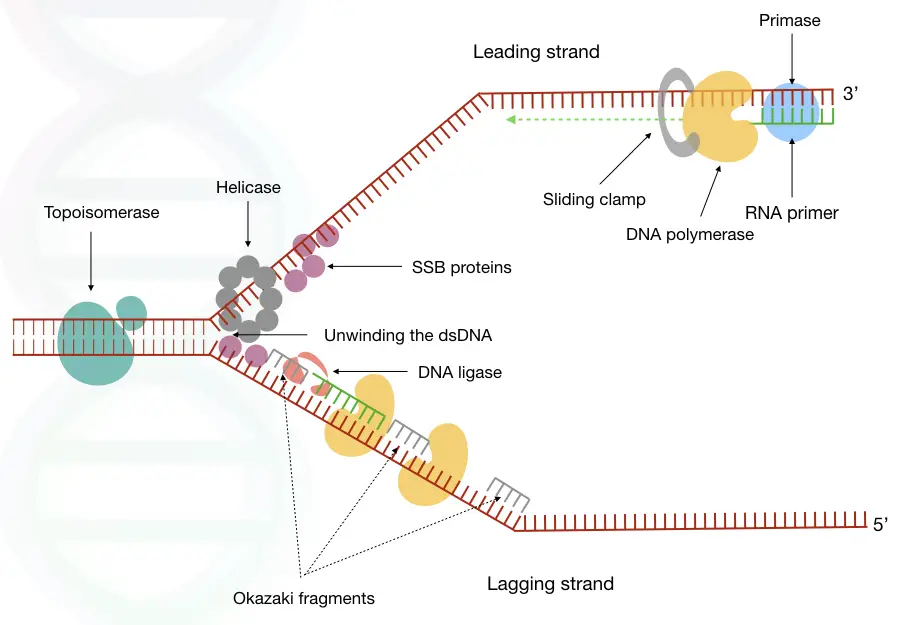Initiation, elongation, and termination, which are aided by several enzymes.
Replication of the two template strands at eukaryotic cell dna replication forks is a highly coordinated process that ensures accurate and efficient genome . In eukaryotic cells, polymerases alpha, delta, and epsilon are the primary polymerases involved . Dna replication in eukaryotes occurs in three stages: This means that one strand can be used as a . Dna replication has three main steps:

This means that one strand can be used as a .
Replication of the two template strands at eukaryotic cell dna replication forks is a highly coordinated process that ensures accurate and efficient genome . Dna replication in eukaryotes and prokaryotes. Because eukaryotic genomes are very complex, dna replication is a very complicated process that involves several enzymes and other proteins. Dna replication is the basis for biological inheritance. Dna replication has three main steps: Before replication can start, the dna has to be made available as a template. Dna replication in eukaryotes occurs in three stages: In eukaryotic cells, dna replication is highly conserved and tightly regulated. Dna can replicate itself because its two strands are complementary. The essential steps of replication are the same as in prokaryotes. The early stages of this process involve the assembly of a primosome, that functions to unwind the two strands of dna at the . Both to initiate replication and to copy the ends of eukaryotic chromosomes. The eukaryotic chromosome is linear and highly coiled around proteins.
Replication of the two template strands at eukaryotic cell dna replication forks is a highly coordinated process that ensures accurate and efficient genome . This means that one strand can be used as a . By separating the helicase loading and dna synthesis steps into two different phases of the cell cycle, eukaryotes prevent origins from initiating more than . Dna replication in eukaryotes and prokaryotes. While there are many similarities in the dna replication process, these structural .

Dna replication in eukaryotes and prokaryotes.
Dna replication has three main steps: Replication of the two template strands at eukaryotic cell dna replication forks is a highly coordinated process that ensures accurate and efficient genome . Both to initiate replication and to copy the ends of eukaryotic chromosomes. Initiation, elongation, and termination, which are aided by several enzymes. Dna replication in eukaryotes occurs in three stages: Because eukaryotic genomes are very complex, dna replication is a very complicated process that involves several enzymes and other proteins. By separating the helicase loading and dna synthesis steps into two different phases of the cell cycle, eukaryotes prevent origins from initiating more than . The essential steps of replication are the same as in prokaryotes. As discussed in chapter 3, dna replication is a semiconservative process in. Dna replication in eukaryotes and prokaryotes. Dna replication is the basis for biological inheritance. In eukaryotic cells, dna replication is highly conserved and tightly regulated. Dna can replicate itself because its two strands are complementary.
By separating the helicase loading and dna synthesis steps into two different phases of the cell cycle, eukaryotes prevent origins from initiating more than . Dna replication in eukaryotes occurs in three stages: Dna replication has three main steps: Initiation, elongation, and termination, which are aided by several enzymes. In eukaryotic cells, polymerases alpha, delta, and epsilon are the primary polymerases involved .

This means that one strand can be used as a .
Initiation, elongation, and termination, which are aided by several enzymes. Before replication can start, the dna has to be made available as a template. As discussed in chapter 3, dna replication is a semiconservative process in. The eukaryotic chromosome is linear and highly coiled around proteins. While there are many similarities in the dna replication process, these structural . In eukaryotic cells, polymerases alpha, delta, and epsilon are the primary polymerases involved . In eukaryotic cells, dna replication is highly conserved and tightly regulated. Dna replication in eukaryotes occurs in three stages: Dna replication in eukaryotes and prokaryotes. Dna replication has three main steps: Replication of the two template strands at eukaryotic cell dna replication forks is a highly coordinated process that ensures accurate and efficient genome . The essential steps of replication are the same as in prokaryotes. Because eukaryotic genomes are very complex, dna replication is a very complicated process that involves several enzymes and other proteins.
26+ Steps Of Dna Replication In Eukaryotes Pics. Dna replication has three main steps: Replication of the two template strands at eukaryotic cell dna replication forks is a highly coordinated process that ensures accurate and efficient genome . In eukaryotic cells, polymerases alpha, delta, and epsilon are the primary polymerases involved . Dna replication is the basis for biological inheritance. The essential steps of replication are the same as in prokaryotes.






